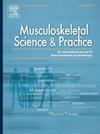运动时的活动诱导疼痛,但单独运动对肘关节外侧肌腱病变患者没有镇痛作用:一项评估者盲法随机交叉试验
IF 2.2
3区 医学
Q1 REHABILITATION
引用次数: 0
摘要
研究背景:非计量运动在健康个体中显示出镇痛作用,而在肘关节外侧肌腱病变(LET)患者中,运动动员(MWM)显示出镇痛作用。本研究旨在探讨LET患者在有或没有MWM的情况下,等长握持运动的局部和远程镇痛效果。方法采用重复测量、交叉随机研究设计,纳入24例临床诊断为LET的患者。每个参与者都进行了三种条件:等距抓握练习(exercise), MWM结合等距抓握练习(MWM + EX),以及每个条件之间至少有10分钟洗脱期的对照条件。主要结局是压力疼痛阈值(PPT)和疼痛时间总和(TS),在局部和远程部位进行评估。次要结果是静止疼痛(pain),使用数值评定量表(NRS 0-10)评估,以及运动任务期间的握力。结果与对照组相比,运动后疼痛立即增加,但MWM + EX没有增加。与对照组相比,MWM + EX在局部和远处部位的PPT均较高,首次针刺疼痛评分较低。TS未见明显变化。与运动相比,当MWM应用时,在收缩期间进行了更大的握力和工作。当与引起疼痛的运动相结合时,MWM产生了镇痛效果。当局部测量时效果最大,但在远处也存在,这表明外周伤害感受器的刺激减少和下行疼痛抑制通路的激活可能支持其疗效。通过减轻运动相关的疼痛和提高握力,MWM可以促进更好地坚持基于运动的康复计划。本文章由计算机程序翻译,如有差异,请以英文原文为准。
Mobilisation-with-movement induces analgesia during exercise but exercise alone is not analgesic in people with lateral elbow tendinopathy: An assessor blinded, randomised crossover trial
Background
Isometric exercise has shown hypoalgesic effects in healthy individuals, while mobilisation-with-movement (MWM) has demonstrated hypoalgesia in people with lateral elbow tendinopathy (LET). This study aimed to explore the local and remote hypoalgesic effects of an isometric gripping exercise, with and without MWM, in individuals with LET.
Methods
A repeated-measures, crossover randomised study design was employed with 24 participants clinically diagnosed with LET. Each participant underwent three conditions: isometric gripping exercise (Exercise), MWM combined with isometric gripping exercise (MWM + EX), and a Control condition with a minimum 10-min wash-out period between each condition. Primary outcomes were pressure pain threshold (PPT) and temporal summation of pain (TS), assessed at local and remote sites. Secondary outcomes were pain at rest (Pain), assessed using a numerical rating scale (NRS 0–10), and grip force during the exercise task.
Results
Compared to control, pain increased immediately following Exercise, but not MWM + EX. Compared to Control, MWM + EX demonstrated higher PPT at both local and remote sites and lower first pinprick pain rating. No changes in TS were observed. Compared to Exercise, greater grip force and work was performed during contractions when MWM was applied.
Discussion
When combined with pain-provoking exercise, MWM produced hypoalgesic effects. Effects were largest when measured locally but also present at remote site, suggesting that both reduced stimulation of peripheral nociceptors and activation of descending pain inhibitory pathways may underpin its efficacy. By mitigating exercise-related pain and improving grip force, MWM may facilitate better adherence to exercise-based rehabilitation programs.
求助全文
通过发布文献求助,成功后即可免费获取论文全文。
去求助
来源期刊

Musculoskeletal Science and Practice
Health Professions-Physical Therapy, Sports Therapy and Rehabilitation
CiteScore
4.10
自引率
8.70%
发文量
152
审稿时长
48 days
期刊介绍:
Musculoskeletal Science & Practice, international journal of musculoskeletal physiotherapy, is a peer-reviewed international journal (previously Manual Therapy), publishing high quality original research, review and Masterclass articles that contribute to improving the clinical understanding of appropriate care processes for musculoskeletal disorders. The journal publishes articles that influence or add to the body of evidence on diagnostic and therapeutic processes, patient centered care, guidelines for musculoskeletal therapeutics and theoretical models that support developments in assessment, diagnosis, clinical reasoning and interventions.
 求助内容:
求助内容: 应助结果提醒方式:
应助结果提醒方式:


